Deck 14: Now That We Are Free: Reconstruction and the New South, 1863-1890
Question
Question
Question
Question
Question
Question
Question
Question
Question
Question
Question
Question
Question
Question
Question
Question
Question
Question
Question
Question
Question
Question
Question
Question
Question
Question
Question
Question
Question
Question
Question
Question
Question
Question
Question
Question
Question
Question
Question
Question
Question
Question
Question
Question
Question
Question
Question
Question
Question
Question

Unlock Deck
Sign up to unlock the cards in this deck!
Unlock Deck
Unlock Deck
1/50
Play
Full screen (f)
Deck 14: Now That We Are Free: Reconstruction and the New South, 1863-1890
1
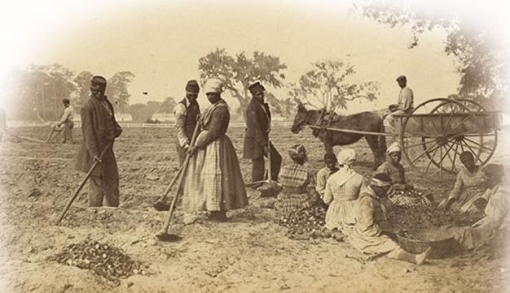
How does this 1862 photograph of ex-slaves planting sweet potatoes on the Sea Islands off the South Carolina coast demonstrate one way in which they expressed their freedom?
A) They refused to plant cotton, which was associated with slavery.
B) They rejected the gang system of slave labor and chose to work individually instead.
C) They grew crops like sweet potatoes and corn on a commercial basis.
D) They restored traditional gender roles and relegated women to housework.
They refused to plant cotton, which was associated with slavery.
2

This brief biography of the African American poet Phillis Wheatley, which was published by the Boston Tract Society, was mainly done to .
A) instill pride in African American students by focusing on black achievements
B) teach both white and black students about prominent African Americans
C) show Southern black children that slavery was beneficial
D) demonstrate that women also played an important role in history
instill pride in African American students by focusing on black achievements
3
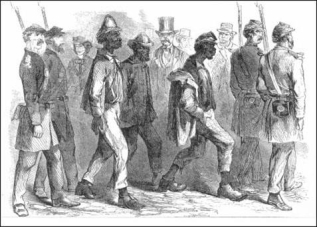
What does this image of freedmen being forcibly returned to their plantations if they ran away or resisted working there reveal about the Louisiana test case of emancipation?
A) Freedmen received no wages for their work on Louisiana plantations.
B) Former slaves gained some autonomy through this test case of emancipation.
C) This system of emancipation was much harsher than the Sea Islands and Davis Bend systems.
D) Ex-slaves still favored this test case because it banned corporal punishment for doing labor.
This system of emancipation was much harsher than the Sea Islands and Davis Bend systems.
4
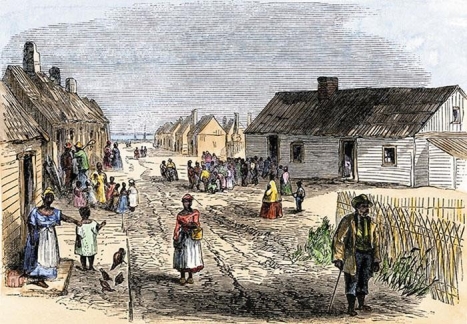
The fact that the church building shown on the right in the freedmen's community of Trent, North Carolina, also served as a school and meetinghouse reflects that .
A) many freedmen communities lacked adequate supplies for building different structures
B) religion played a minimal role in the lives of many freedmen
C) freedmen did not have the capacity to establish their own institutions
D) black churches addressed freedmen's spiritual and social needs

Unlock Deck
Unlock for access to all 50 flashcards in this deck.
Unlock Deck
k this deck
5
What was the goal of the Wade-Davis Bill?
A) It set up a more lenient Reconstruction plan than Lincoln's Ten Percent Plan.
B) It was designed to build up the Republican Party in the South by stripping all white male Southerners of their voting rights.
C) It allowed Southern states to reestablish new governments immediately after the end of the Civil War.
D) It was designed to punish Confederate leaders and destroy the South's slave society by extending a longer period of Reconstruction in the South.
A) It set up a more lenient Reconstruction plan than Lincoln's Ten Percent Plan.
B) It was designed to build up the Republican Party in the South by stripping all white male Southerners of their voting rights.
C) It allowed Southern states to reestablish new governments immediately after the end of the Civil War.
D) It was designed to punish Confederate leaders and destroy the South's slave society by extending a longer period of Reconstruction in the South.

Unlock Deck
Unlock for access to all 50 flashcards in this deck.
Unlock Deck
k this deck
6
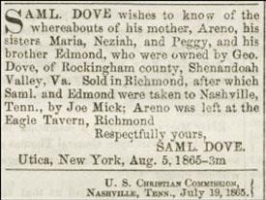
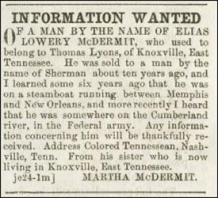
What do these advertisements from the Colored Tennessean indicate about the unrestricted mobility that former slaves suddenly had after emancipation?
A) Former slaves left their old plantations, which were home to many bitter memories.
B) Some ex-slaves just decided to wander for pleasure with no particular designation in mind.
C) Freedmen searched for loved ones who had been sold away years before.
D) African Americans decided to move to urban areas in search of better job opportunities.

Unlock Deck
Unlock for access to all 50 flashcards in this deck.
Unlock Deck
k this deck
7
In what way did the Davis Bend, Mississippi, plantations owned by Confederate President Jefferson Davis and his brother Joseph become a model as an emancipation test case?
A) Former slaves were paid, but were otherwise limited in their autonomy.
B) Former slaves ran the plantations autonomously.
C) Former slaves leased the land to whites and lived off the profits.
D) Former slaves pursued their education while continuing to work the land.
A) Former slaves were paid, but were otherwise limited in their autonomy.
B) Former slaves ran the plantations autonomously.
C) Former slaves leased the land to whites and lived off the profits.
D) Former slaves pursued their education while continuing to work the land.

Unlock Deck
Unlock for access to all 50 flashcards in this deck.
Unlock Deck
k this deck
8
How did Lincoln respond to the Wade-Davis Bill?
A) He signed it into law.
B) He issued a direct veto of the bill.
C) He quietly pocket vetoed the bill.
D) He sent it back to Congress so that it could be rewritten in stricter terms.
A) He signed it into law.
B) He issued a direct veto of the bill.
C) He quietly pocket vetoed the bill.
D) He sent it back to Congress so that it could be rewritten in stricter terms.

Unlock Deck
Unlock for access to all 50 flashcards in this deck.
Unlock Deck
k this deck
9
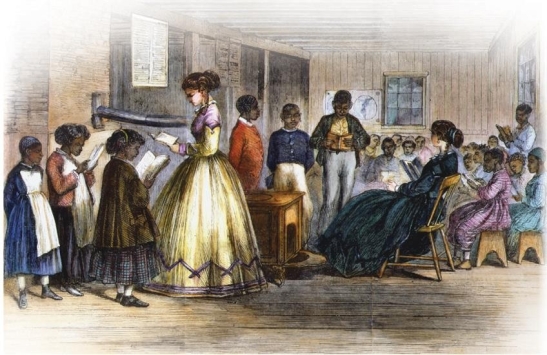
The portrayal of the children in the illustration of the Cooke sisters' schoolroom was most likely intended to .
A) promote desegregated schools
B) counter popular views of African Americans as uncivilized
C) reveal the failures of the Freedmen's Bureau
D) demonstrate the superiority of white teachers

Unlock Deck
Unlock for access to all 50 flashcards in this deck.
Unlock Deck
k this deck
10
When issuing the code that stated "All rogues and vagabonds…shall be deemed and considered vagrants…," why did the Mississippi legislature define "vagrancy" in such broad terms?
A) They believed the general public understood the meaning of this term.
B) This allowed white Southerners to arrest freedmen at will and curtail their freedom.
C) They did not want to violate the provisions of the Thirteenth Amendment.
D) This made it easier to condemn freedmen for more severe crimes.
A) They believed the general public understood the meaning of this term.
B) This allowed white Southerners to arrest freedmen at will and curtail their freedom.
C) They did not want to violate the provisions of the Thirteenth Amendment.
D) This made it easier to condemn freedmen for more severe crimes.

Unlock Deck
Unlock for access to all 50 flashcards in this deck.
Unlock Deck
k this deck
11
How did Southerners react to freedmen's new access to greater mobility?
A) They allowed them to travel freely.
B) They passed vagrancy laws to restrict their movements.
C) They required former slaves to carry travelling passes when leaving their plantations.
D) They assisted freedmen by supplying them with mules and wagons.
A) They allowed them to travel freely.
B) They passed vagrancy laws to restrict their movements.
C) They required former slaves to carry travelling passes when leaving their plantations.
D) They assisted freedmen by supplying them with mules and wagons.

Unlock Deck
Unlock for access to all 50 flashcards in this deck.
Unlock Deck
k this deck
12
Special Field Order No. 15 provided .
A) jobs to ex-slaves
B) education to African-American children
C) land to freedmen
D) territory for the establishment of black communities
A) jobs to ex-slaves
B) education to African-American children
C) land to freedmen
D) territory for the establishment of black communities

Unlock Deck
Unlock for access to all 50 flashcards in this deck.
Unlock Deck
k this deck
13
Reconstruction referred not only to remaking the war-torn South but also to .
A) incorporating Western states into the Union
B) reforming Confederate leadership
C) finding new employment for former slaves
D) reestablishing the Union torn by secession
A) incorporating Western states into the Union
B) reforming Confederate leadership
C) finding new employment for former slaves
D) reestablishing the Union torn by secession

Unlock Deck
Unlock for access to all 50 flashcards in this deck.
Unlock Deck
k this deck
14
How does artist Winslow Homer capture the complexities and challenges associated with the attempt to remake Southern society after the end of the Civil War in his painting A Visit from the Old Mistress?
A) The painting captures the affinity that slaveholders and slaves shared before emancipation.
B) The painting shows that former slaves still were subservient to their former owners.
C) The painting illustrates how former slaveholders attempted to reconcile with their former slaves.
D) The painting depicts the suspicions and contempt that former slaves had for their former owners.
A) The painting captures the affinity that slaveholders and slaves shared before emancipation.
B) The painting shows that former slaves still were subservient to their former owners.
C) The painting illustrates how former slaveholders attempted to reconcile with their former slaves.
D) The painting depicts the suspicions and contempt that former slaves had for their former owners.

Unlock Deck
Unlock for access to all 50 flashcards in this deck.
Unlock Deck
k this deck
15
Why was Abraham Lincoln's Reconstruction policy called the "Ten Percent Plan"?
A) Former Confederate states could reestablish their governments once 10 percent of voters pledged loyalty to the Union.
B) A 10 percent income tax would be levied on the residents of all former Confederate states.
C) It would forgive all Southerners except for high-ranking officials and military officers and the top 10 percent of the population in terms of wealth.
D) It would set aside 10 percent of Southern land to be granted to freedmen.
A) Former Confederate states could reestablish their governments once 10 percent of voters pledged loyalty to the Union.
B) A 10 percent income tax would be levied on the residents of all former Confederate states.
C) It would forgive all Southerners except for high-ranking officials and military officers and the top 10 percent of the population in terms of wealth.
D) It would set aside 10 percent of Southern land to be granted to freedmen.

Unlock Deck
Unlock for access to all 50 flashcards in this deck.
Unlock Deck
k this deck
16
Like many black teachers, black ministers .
A) held lowly paid positions in their communities
B) turned to white Southerners for assistance in gaining equality
C) entered politics to advance the cause of black equality
D) raised money and ran programs such as temperance societies
A) held lowly paid positions in their communities
B) turned to white Southerners for assistance in gaining equality
C) entered politics to advance the cause of black equality
D) raised money and ran programs such as temperance societies

Unlock Deck
Unlock for access to all 50 flashcards in this deck.
Unlock Deck
k this deck
17
Why was the establishment of the Freedmen's Bureau, which became an all-purpose relief society in the war-ravaged South, significant?
A) It was the first attempt by the federal government to provide social welfare services.
B) It dealt exclusively with poor whites in the South.
C) It was organized to keep former slaves on their plantations.
D) It was the first agency aimed at procuring land for ex-slaves to own.
A) It was the first attempt by the federal government to provide social welfare services.
B) It dealt exclusively with poor whites in the South.
C) It was organized to keep former slaves on their plantations.
D) It was the first agency aimed at procuring land for ex-slaves to own.

Unlock Deck
Unlock for access to all 50 flashcards in this deck.
Unlock Deck
k this deck
18
Lincoln's second inaugural address, which stated he would deal with the defeated South "with malice toward none" and "charity for all," showed that his proposed plan of Reconstruction would be in nature.
A) lenient
B) moderate
C) severe
D) ambiguous
A) lenient
B) moderate
C) severe
D) ambiguous

Unlock Deck
Unlock for access to all 50 flashcards in this deck.
Unlock Deck
k this deck
19
Why did Congress feel it necessary to pass the Thirteenth Amendment, which abolished slavery in the United States?
A) They believed that African Americans were racially equal to whites.
B) They wanted to end slavery in all parts of the nation, including the Border States.
C) They wanted to guarantee voting rights to former slaves.
D) They wanted to ensure that freedmen and whites could live together in mutual respect.
A) They believed that African Americans were racially equal to whites.
B) They wanted to end slavery in all parts of the nation, including the Border States.
C) They wanted to guarantee voting rights to former slaves.
D) They wanted to ensure that freedmen and whites could live together in mutual respect.

Unlock Deck
Unlock for access to all 50 flashcards in this deck.
Unlock Deck
k this deck
20
How did President Andrew Johnson's Reconstruction plan contradict his views when he first assumed the presidency?
A) He outlined a lenient policy designed to rapidly reestablish Southern state governments although he promised to harshly punish the South.
B) He refused to take away freedmen's access to land although he was an avowed racist.
C) He renounced the Thirteenth Amendment although he wanted freedmen to have more rights.
D) He denied pardons and amnesty to any Southerner who took an oath of allegiance even though he initially called for leniency.
A) He outlined a lenient policy designed to rapidly reestablish Southern state governments although he promised to harshly punish the South.
B) He refused to take away freedmen's access to land although he was an avowed racist.
C) He renounced the Thirteenth Amendment although he wanted freedmen to have more rights.
D) He denied pardons and amnesty to any Southerner who took an oath of allegiance even though he initially called for leniency.

Unlock Deck
Unlock for access to all 50 flashcards in this deck.
Unlock Deck
k this deck
21
The Panic of 1873 affected Reconstruction by focusing Northerners' attention on
A) black enfranchisement
B) economic issues such as currency reform
C) cash crops in the South
D) the development of Southern industry
A) black enfranchisement
B) economic issues such as currency reform
C) cash crops in the South
D) the development of Southern industry

Unlock Deck
Unlock for access to all 50 flashcards in this deck.
Unlock Deck
k this deck
22
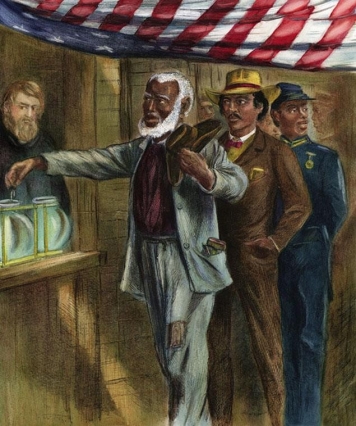
This 1867 magazine cover from Harper's Weekly, which shows blacks voting for the first time, uses a well-dressed man wearing a hat in the middle of this image to represent a(n)
A) sharecropper
B) educated Republican leader
C) Union soldier
D) scalawag

Unlock Deck
Unlock for access to all 50 flashcards in this deck.
Unlock Deck
k this deck
23
Why did women activists like Elizabeth Cady Stanton and Susan B. Anthony oppose ratification of the Fifteenth Amendment?
A) It did not provide universal suffrage for both men and women.
B) It restricted suffrage to middle class and rich African Americans.
C) It gave women suffrage but failed to do so for African Americans.
D) It would establish an interracial democracy, which made them uncomfortable.
A) It did not provide universal suffrage for both men and women.
B) It restricted suffrage to middle class and rich African Americans.
C) It gave women suffrage but failed to do so for African Americans.
D) It would establish an interracial democracy, which made them uncomfortable.

Unlock Deck
Unlock for access to all 50 flashcards in this deck.
Unlock Deck
k this deck
24
How did the Civil Rights Act counteract Southern resistance and the oppression of freedmen?
A) It expanded the powers of the Freedmen's Bureau for two more years.
B) It outlawed Southern terror groups like the Ku Klux Klan.
C) It declared that all African Americans and persons born in the United States were citizens.
D) It abolished slavery in all Southern states.
A) It expanded the powers of the Freedmen's Bureau for two more years.
B) It outlawed Southern terror groups like the Ku Klux Klan.
C) It declared that all African Americans and persons born in the United States were citizens.
D) It abolished slavery in all Southern states.

Unlock Deck
Unlock for access to all 50 flashcards in this deck.
Unlock Deck
k this deck
25
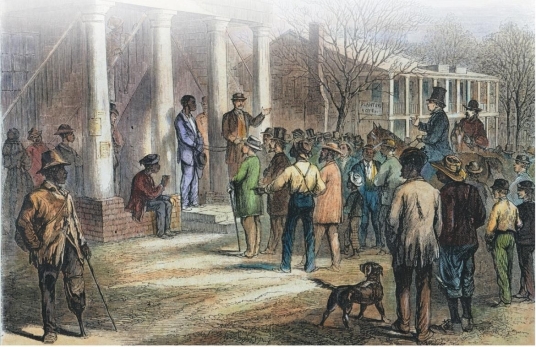
The drawing The Black Codes in Action depicts the practice of .
A) allowing freedmen to rent land only in rural areas
B) terrorizing and lynching African American men by white supremacists
C) reestablishing the gang labor system through mass convictions of vagrancy
D) auctioning off the service of black men who were convicted of vagrancy

Unlock Deck
Unlock for access to all 50 flashcards in this deck.
Unlock Deck
k this deck
26
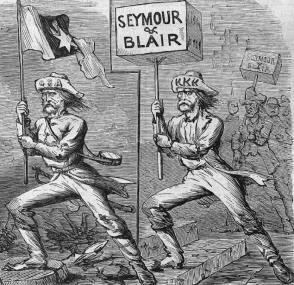
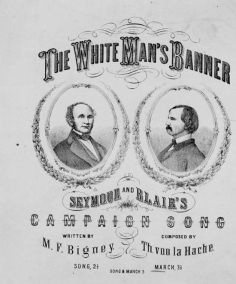
What do the political cartoon "Tis But A Change of Banners" and the song sheet "The White Man's Banner" imply about the political tactics that Democratic presidential nominee Horatio Seymour used in the 1868 presidential election?
A) Seymour suggested that the rights of African Americans were in danger unless the Democrats won.
B) Seymour supported the integration of blacks and whites in all parts of the nation.
C) Seymour used racist messages to show how black suffrage threatened white Americans.
D) Seymour supported an expansion of voting rights for larger numbers of African Americans.

Unlock Deck
Unlock for access to all 50 flashcards in this deck.
Unlock Deck
k this deck
27
The concern raised by African American Republican George M. Arnold when he stated that "it seems to me that we are drifting, drifting back under the leadership of the slaveholders. Our former masters are fast taking the reins of government," was basically the result of .
A) the rising power of the Ku Klux Klan and other white terrorist groups
B) Grant's Amnesty Act, which made most Confederate leaders eligible to vote and hold office
C) the implementation of the sharecropping system
D) the work of the Freedmen's Bureau
A) the rising power of the Ku Klux Klan and other white terrorist groups
B) Grant's Amnesty Act, which made most Confederate leaders eligible to vote and hold office
C) the implementation of the sharecropping system
D) the work of the Freedmen's Bureau

Unlock Deck
Unlock for access to all 50 flashcards in this deck.
Unlock Deck
k this deck
28
Horace Greeley's 1870 statements regarding Reconstruction as a failure because the reconstructed Southern state governments were based on "ignorance and degradation" and should return to white rule reflected the views of the .
A) Liberal Republicans
B) Redeemers
C) Radical Republicans
D) Readjusters
A) Liberal Republicans
B) Redeemers
C) Radical Republicans
D) Readjusters

Unlock Deck
Unlock for access to all 50 flashcards in this deck.
Unlock Deck
k this deck
29
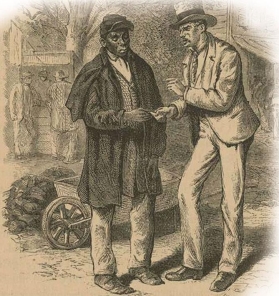
The native-born white Southern Republican depicted in this image as an opportunist seeking political power by manipulating the black vote is known as a .
A) scalawag
B) carpetbagger
C) Redeemer
D) Radical Republican

Unlock Deck
Unlock for access to all 50 flashcards in this deck.
Unlock Deck
k this deck
30
Why did Congress feel it was important to pass the Fourteenth Amendment although the recently passed Civil Rights Act had the same purpose?
A) President Johnson had vetoed the Civil Rights Act in an effort to thwart racial equality.
B) The Civil Rights Act did not clearly define the rights of all citizens regardless of race.
C) The Civil Rights Act could be overturned by a future Congress, but an amendment made it a permanent part of the Constitution.
D) The Civil Rights Act did not go far enough in eliminating the Black Codes that deprived citizens of "fundamental rights."
A) President Johnson had vetoed the Civil Rights Act in an effort to thwart racial equality.
B) The Civil Rights Act did not clearly define the rights of all citizens regardless of race.
C) The Civil Rights Act could be overturned by a future Congress, but an amendment made it a permanent part of the Constitution.
D) The Civil Rights Act did not go far enough in eliminating the Black Codes that deprived citizens of "fundamental rights."

Unlock Deck
Unlock for access to all 50 flashcards in this deck.
Unlock Deck
k this deck
31
What caused many of the former Confederate states to run up huge debts under Republican- controlled state governments in the late 1860s?
A) inequitable tax codes between whites and blacks
B) financial support for the Freedmen's Bureau
C) redistribution of land to former slaves
D) the rapid expansion of government services and expenditures
A) inequitable tax codes between whites and blacks
B) financial support for the Freedmen's Bureau
C) redistribution of land to former slaves
D) the rapid expansion of government services and expenditures

Unlock Deck
Unlock for access to all 50 flashcards in this deck.
Unlock Deck
k this deck
32
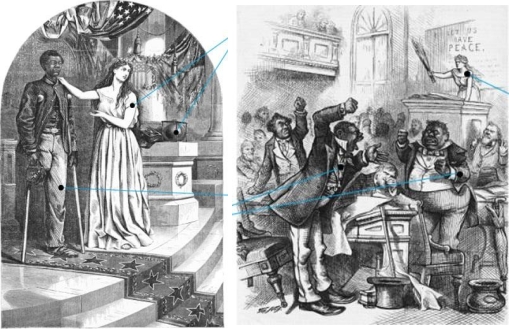
What do Harper's Weekly cartoonist Thomas Nast's 1865 cartoon And Not This Man? and his 1874 cartoon Colored Rule in a Reconstructed (?) State reveal about his attitudes toward Reconstruction during the span of its existence?
A) Nast's images changed from portraying blacks as racist caricatures to noble individuals during the Reconstruction era.
B) Nast's initial racist attitudes toward blacks were altered as he saw them become agents of their own liberty during Reconstruction.
C) Nast's impression of this time period transformed from a progressive view to a reactionary one as he grew disillusioned with Reconstruction's failures.
D) Nast was a strong supporter of black suffrage and believed that African Americans in the South had earned the right to govern themselves after the end of Reconstruction.

Unlock Deck
Unlock for access to all 50 flashcards in this deck.
Unlock Deck
k this deck
33
What was President Johnson's fate after he vetoed the Reconstruction Acts?
A) He was removed as president after impeachment by the House and conviction by the Senate.
B) He was impeached in the House, but the Senate failed to convict him by one vote.
C) He was reelected to a second term in 1868.
D) He resigned the presidency.
A) He was removed as president after impeachment by the House and conviction by the Senate.
B) He was impeached in the House, but the Senate failed to convict him by one vote.
C) He was reelected to a second term in 1868.
D) He resigned the presidency.

Unlock Deck
Unlock for access to all 50 flashcards in this deck.
Unlock Deck
k this deck
34
Why did Republicans in Congress want a slower system of Reconstruction than what President Johnson had proposed?
A) This would give the Republican Party in the South time to build its strength.
B) This would reduce the amount of civil liberties that freedmen had initially received.
C) This would give the Southern economy the opportunity to refurbish its cotton industry.
D) This would allow Southern Democrats the chance to control their state governments.
A) This would give the Republican Party in the South time to build its strength.
B) This would reduce the amount of civil liberties that freedmen had initially received.
C) This would give the Southern economy the opportunity to refurbish its cotton industry.
D) This would allow Southern Democrats the chance to control their state governments.

Unlock Deck
Unlock for access to all 50 flashcards in this deck.
Unlock Deck
k this deck
35
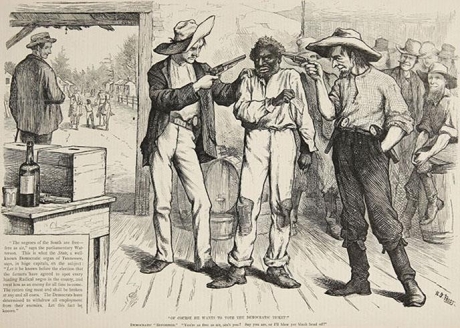
The 1876 image Of Course He Wants to Vote the Democratic Ticket shows that the ruthless character of the white supremacy movement, which was typical of the Mississippi Plan used to intimidate black voters, was the result of the .
A) expiration of the Freedmen's Bureau
B) lack of concern from Republican governors in Southern states
C) Fifteenth Amendment
D) reduction of federal troops in the South

Unlock Deck
Unlock for access to all 50 flashcards in this deck.
Unlock Deck
k this deck
36
What did Congress require from each former Confederate state before they were readmitted to the Union?
A) free public education for black children and voting rights for freedmen
B) Republican-controlled state legislatures and ratification of the Thirteenth Amendment
C) state constitutions with universal male suffrage and ratification of the Fourteenth Amendment
D) abolishment of the Black Codes and suppression of white terror groups
A) free public education for black children and voting rights for freedmen
B) Republican-controlled state legislatures and ratification of the Thirteenth Amendment
C) state constitutions with universal male suffrage and ratification of the Fourteenth Amendment
D) abolishment of the Black Codes and suppression of white terror groups

Unlock Deck
Unlock for access to all 50 flashcards in this deck.
Unlock Deck
k this deck
37
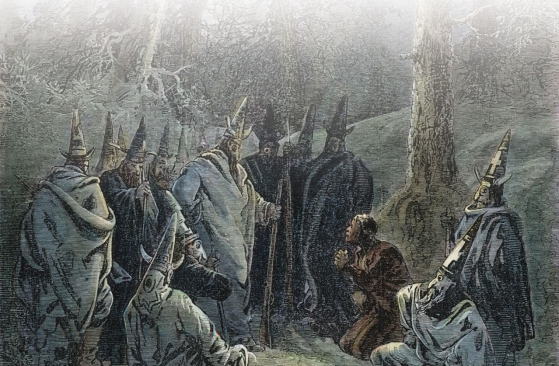
How did President Grant's administration respond to the anti-black violence, as shown in this image from Moore County, North Carolina, that was used by terrorist organizations such as the Ku Klux Klan?
A) It appointed Redeemer governments in the South to protect African Americans.
B) It passed Enforcement Acts that outlawed "armed combinations" that deprived anyone's civil rights.
C) It expanded the powers of the Freedmen's Bureau to protect blacks in the South.
D) It sent larger numbers of federal troops to the Southern states to maintain law and order.

Unlock Deck
Unlock for access to all 50 flashcards in this deck.
Unlock Deck
k this deck
38
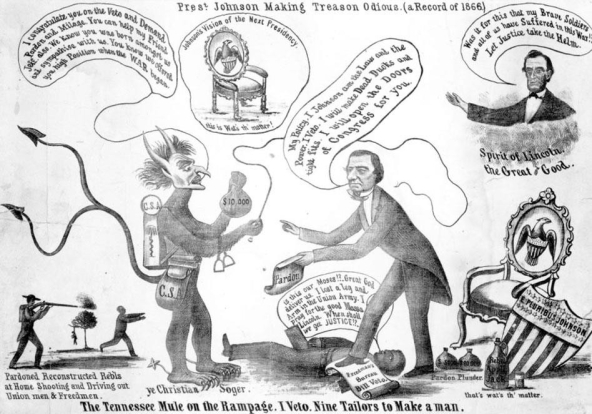
What was the illustrator's motivation for publishing this political cartoon, which addressed President Andrew Johnson's Reconstruction policy?
A) He was praising Johnson for quickly readmitting the reconstructed Southern states.
B) He was sympathizing with Johnson for having to deal with the Radical Republicans.
C) He was condemning Johnson for his lenient position on pardoning former Confederates.
D) He was admiring Johnson for carrying on Abraham Lincoln's Reconstruction policy.

Unlock Deck
Unlock for access to all 50 flashcards in this deck.
Unlock Deck
k this deck
39
The Redeemers portrayed themselves as the _ .
A) leaders who had saved the Union from Confederate treason
B) valiant enforcers of the Constitution and states' rights
C) saviors of the South from the injustices of Republican rule
D) protectors of freedmen
A) leaders who had saved the Union from Confederate treason
B) valiant enforcers of the Constitution and states' rights
C) saviors of the South from the injustices of Republican rule
D) protectors of freedmen

Unlock Deck
Unlock for access to all 50 flashcards in this deck.
Unlock Deck
k this deck
40
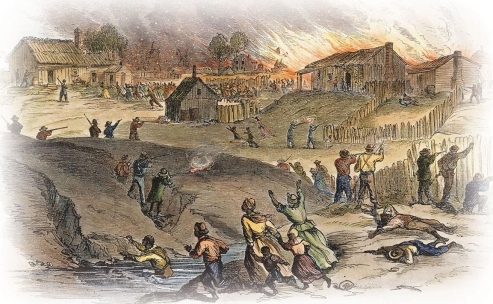
What was the main purpose of this drawing from Harper's Weekly that depicted the Memphis race riots of May 1-2, 1866, which resulted in the deaths of 46 blacks and two whites?
A) to promote the racial inferiority of blacks
B) to gain Northern opposition to Johnson's lenient Reconstruction policies
C) to show that Tennessee was not yet ready for readmission to the Union
D) to counteract Southern implementation of the Black Codes

Unlock Deck
Unlock for access to all 50 flashcards in this deck.
Unlock Deck
k this deck
41
The term "Jim Crow" referred to .
A) African American sharecroppers
B) the small group of Southern African Americans who managed to retain the vote
C) the emergence of such white supremacist groups as the Ku Klux Klan
D) the Southern system of segregation and black disenfranchisement
A) African American sharecroppers
B) the small group of Southern African Americans who managed to retain the vote
C) the emergence of such white supremacist groups as the Ku Klux Klan
D) the Southern system of segregation and black disenfranchisement

Unlock Deck
Unlock for access to all 50 flashcards in this deck.
Unlock Deck
k this deck
42
A prominent figure in promoting the New South economy was .
A) Confederate General Robert E. Lee
B) newspaper editor Henry Grady
C) African American activist Frederick Douglass
D) Wall Street titan Jay Gould
A) Confederate General Robert E. Lee
B) newspaper editor Henry Grady
C) African American activist Frederick Douglass
D) Wall Street titan Jay Gould

Unlock Deck
Unlock for access to all 50 flashcards in this deck.
Unlock Deck
k this deck
43
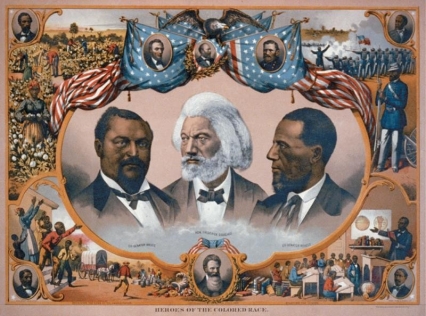
What does the image Heroes of the Colored Race represent about middle-class African Americans?
A) They perceived themselves as superior to poor African Americans.
B) They saw African American achievement as a thing of the past.
C) They looked to their history to cultivate their hopes for the future.
D) They placed greater hope in insurrection than in education.

Unlock Deck
Unlock for access to all 50 flashcards in this deck.
Unlock Deck
k this deck
44
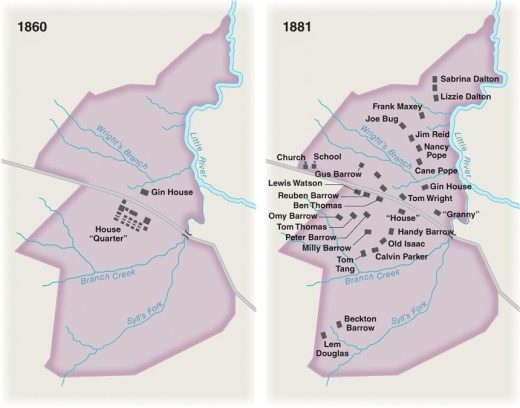
What do the maps of the Barrow Plantation suggest about the settlement patterns of African American tenant farmers over a 20-year period?
A) Their housing was no longer confined to narrow areas of a plantation.
B) Institutions such as churches and schools played a marginal role in their communities.
C) They lived with whites in more integrated communities after the war.
D) They took over plantations and encouraged other African Americans to settle alongside them.

Unlock Deck
Unlock for access to all 50 flashcards in this deck.
Unlock Deck
k this deck
45
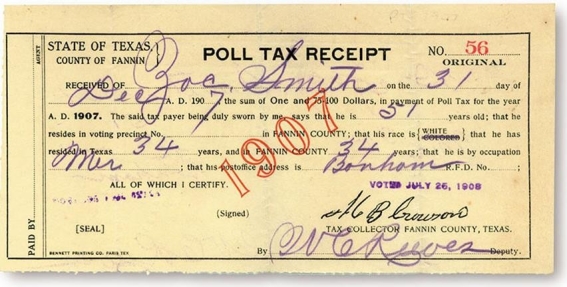
How does this image of a Texas poll tax receipt exemplify the ineffectiveness of the Fifteenth Amendment when it came to the enfranchisement of African Americans?
A) The amendment allowed states to establish property requirements for suffrage, and at the time most African Americans did not own land or property.
B) The amendment stated that suffrage could not be denied or abridged because of "race, color, or previous condition of servitude," so Southerners found other ways to disenfranchise blacks.
C) The amendment used flowery, indirect language that was too vague and therefore very easy to undermine.
D) The amendment denied suffrage to anyone who was unable to read and write.

Unlock Deck
Unlock for access to all 50 flashcards in this deck.
Unlock Deck
k this deck
46
What were the characteristics of the New South that emerged after the end of Reconstruction?
A) equal voting rights, sharecropping, and equal education
B) segregation, white supremacy, and a positive economic transformation
C) one-party rule, a diversified economy, and equal facilities for all
D) disenfranchisement of blacks, expansion of industry, and benevolence toward the North
A) equal voting rights, sharecropping, and equal education
B) segregation, white supremacy, and a positive economic transformation
C) one-party rule, a diversified economy, and equal facilities for all
D) disenfranchisement of blacks, expansion of industry, and benevolence toward the North

Unlock Deck
Unlock for access to all 50 flashcards in this deck.
Unlock Deck
k this deck
47
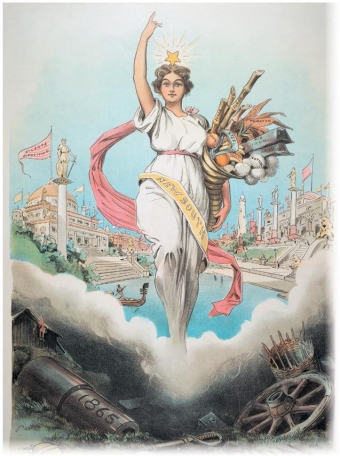
In this poster from the Atlanta Exposition of 1895, what do the items in "Liberty's" cornucopia represent?
A) goods imported from Northern factories
B) the bounties of slave labor and sharecropping
C) the destruction and lingering controversies of the Civil War
D) traditional Southern products like cotton and sugar and newer products like steel and iron

Unlock Deck
Unlock for access to all 50 flashcards in this deck.
Unlock Deck
k this deck
48
Which statement best describes the outcome of the Compromise of 1877?
A) The Democrats ultimately lost because of Samuel J. Tilden's unpopularity.
B) The Republicans exchanged the presidency for railroad monopolies.
C) The South gave up the presidency in exchange for more regional autonomy.
D) Northern apathy resulted in the victory of a Southern Democrat.
A) The Democrats ultimately lost because of Samuel J. Tilden's unpopularity.
B) The Republicans exchanged the presidency for railroad monopolies.
C) The South gave up the presidency in exchange for more regional autonomy.
D) Northern apathy resulted in the victory of a Southern Democrat.

Unlock Deck
Unlock for access to all 50 flashcards in this deck.
Unlock Deck
k this deck
49
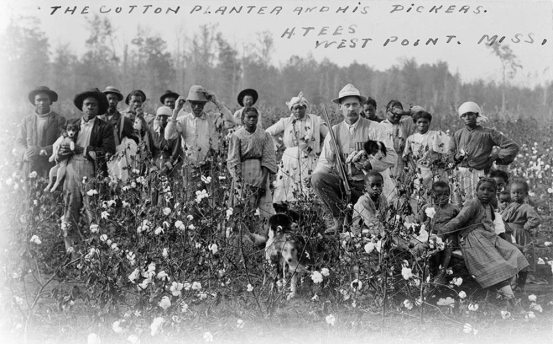
What does this photograph labeled "The Cotton Planter And His Pickers," which shows a well-dressed landowner holding a rifle in Mississippi and black sharecroppers on his farm, demonstrate about the relationship between these two groups?
A) Landlords and their sharecroppers had a benevolent association where each helped out the other.
B) Sharecroppers lived a comfortable lifestyle where they were free from direct white supervision.
C) Sharecroppers lived under the control of landlords, thus reflecting a disparity in power.
D) Sharecropping was limited exclusively to African Americans.

Unlock Deck
Unlock for access to all 50 flashcards in this deck.
Unlock Deck
k this deck
50
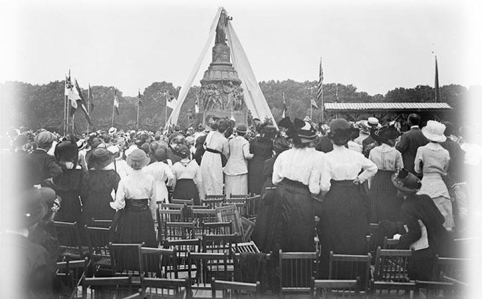
How does this 1890 photograph of the unveiling of Robert E. Lee's memorial in Richmond reflect the ideal of the Lost Cause?
A) It preserved the obligation of keeping the memory of Confederate glory alive.
B) It reminded Southerners to atone for their responsibility in starting the Civil War.
C) It set forth the vision for healing relations with the North.
D) It presented the South as the aggressors of a bloody chapter in our nation's history.

Unlock Deck
Unlock for access to all 50 flashcards in this deck.
Unlock Deck
k this deck



